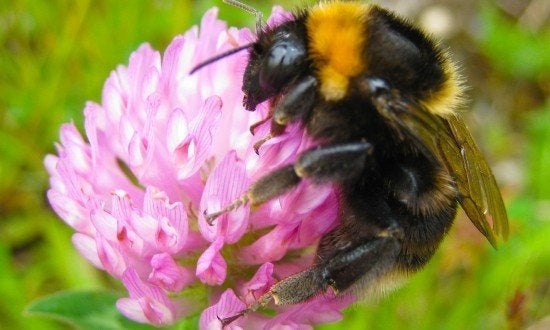
Children and bees are a winning combination. They really are. I learned this last summer when I planted bee-friendly gardens with kids at five summer camps. I knew it would work, even though women at three different nurseries muttered, "Telling kids to attract bees. Good luck with that..."
I had very good luck with that. In fact, of all the things I'd done with kids that involved the environment, whether it was applauding a town mayor on a solar-electric bike, singing for the Hudson River, or making garbage into art, planting bee gardens felt like the most successful project I'd ever undertaken with kids.
I would arrive at camps and say three things off the bat:
Bees are important.
Bees need more summer and fall flowers.
Bees don't like to sting. They die after one sting.
Corollary: If you're truly afraid of getting stung, don't drink soda or juice outside, because yellow jackets love soda, and they can sting ad infinitum.
I downplayed exactly how much bees need our help right now. I didn't mention the sci-fi strangeness of Colony Collapse Disorder, where bees vanish without so much as a trace of translucent wing, and I didn't go into detail about the more alarming context of an overall weakened bee population. Nor did I discuss at length what the loss of bees would do to our food system.
I didn't have to. When I talked with campers, we just talked "forage," also known as flowers. The causes of destabilized populations are myriad. In fact, that's the latest theory: it's not one problem but synergies of problematic variables like chemicals and mites. There is major consensus, however, that bees need more "forage" to tackle these challenges.
It seems like there is "forage" everywhere until we add up the shrinking territory for flowers. The following landscapes are deserts to bees: weed-free lawns, cornfields, rice fields, wheat fields, golf courses, parking lots, roads and roofs. Bees can fly about eight miles maximum for nectar, and the outer limit of this distance exhausts them. More flowers, closer together, are an excellent first defense for bees' immunity systems.
So, the campers, counselors and I got to work. We planted small, ornamental bee-friendly gardens with the potted plants I'd brought from a nearby nursery. Michaela Medina, a self-proclaimed "horti-maniac" who writes the lovely Gardener's Eden blog, sent me lists of bee-friendly flowers for each region I was visiting, though sometimes the best plants I found were the ones that just had bees all over them at the store, like the handsome but unfortunately-named Scabiosa.
Many kids had never un-potted and planted a plant in the ground. They were expert swimmers, archers, and hikers, but this ordinary task had never been on the activity list. Planting a plant is a nurturing act, and it was so nice to see nine-year-old boys and eleven- year-old girls alike taking their responsibilities so seriously. The "fear of bees" discussion became the "care for bees" discussion. At the end, we stood back and admired our beautiful work, complete with a few incoming bees.
But why would I say this is more successful than other eco-projects I'd been a part of? It took a while to figure out, but I finally realized that gardens are more proactive than reactive. We were setting nature in motion more than we were halting our damage to it.
When you dedicate a solar panel, sing a song about cleaning up a waterway, or make an oatmeal container into a drum, you're committing to a remediation of human problems, creating a softer, more harmonious human impact on the Earth. That's meaningful, and it counts.
When you're planting flowers for bees, you're switching on the perpetual motion machine of nature, where bees spiral in cycles of industry that create and recreate the natural world itself, which means our work on bee gardens is a partnering act of creation. At an elemental level, letting nature do its thing makes sense to children. As Laura Perkins, a master gardener for the tour de force Stone Barns at Blue Hill, says, "Kids love reason."
I'm heading out to more camps this summer, and I'm excited to counter any cynicism I encounter. Bee gardens are great.
And if you want to grow some bee-friendly flowers at the edge of a driveway or around a mailbox, you should. Don't let the fear of stinging or your "brown thumb" dissuade you. An easy-to-plant bee-friendly garden (that comes back year after year) is an easy computer search away. And when you do plant flowers, try to plant them with children, who, like bees, are industrious, clever and fast-moving, and who like bees, love to co-create the genius and miracles of nature.